New Mars Forums
You are not logged in.
- Topics: Active | Unanswered
Announcement
#1 2024-05-17 06:44:49
- PhotonBytes
- Member
- From: USA
- Registered: 2019-12-28
- Posts: 58
Mega Igloo ice cavity in Korolev Crater
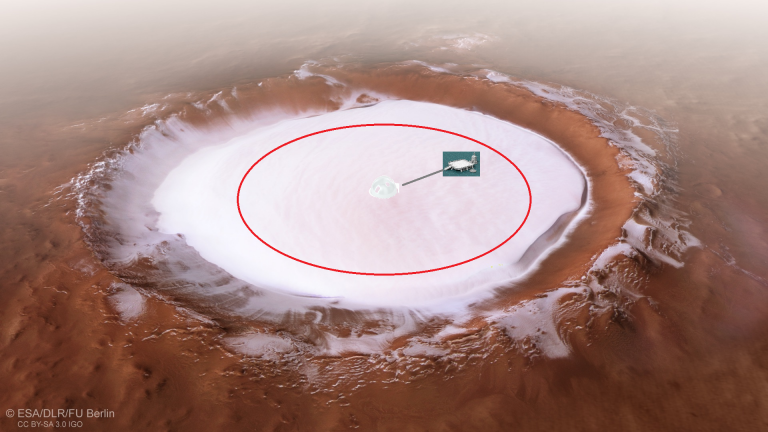
Red: Under Ice Centrifuge for living habitat.
Center: Glass Dome covering base acting as drill base to water reservoire with 1 bar of air pressure.
Green thing I : Rocket landing pad for Starship self landing rocket.
Black Line between base and pad: Road.
Update: Description on my website or each pic but step 3 and step 4 needs to be scaled down because we don't want a perfect cavity and allow gravitational stress on the top layer ice although gravity is less thats true but if we want to be absolutely safe we can leave some ice pilars between top and bottom ice by doing some old fashioned shoveling and drilling in the cavity to enlarge it gradually.
In comic book format how to DIY your own 1g, 1bar habitat with massive air and ground volume under Korolev Crater:
https://photonbytes.com/2024/05/17/mart … ter-igloo/
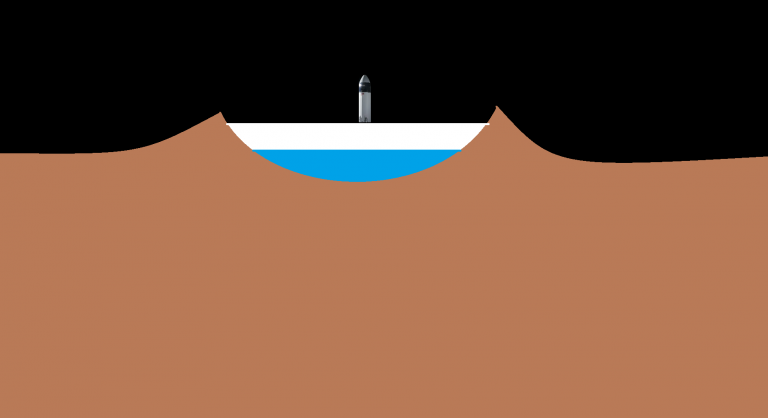
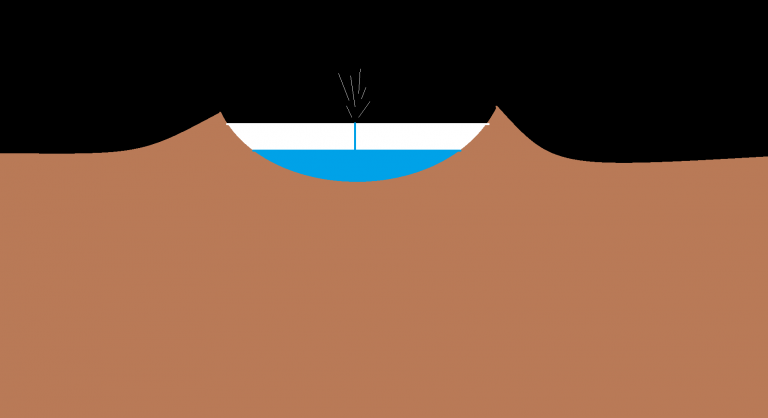
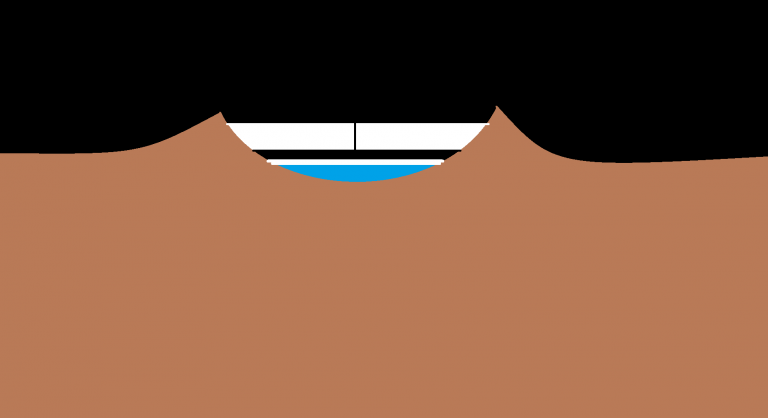


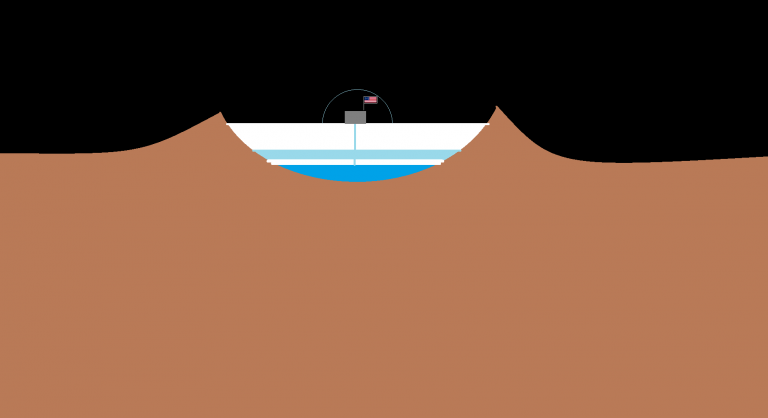
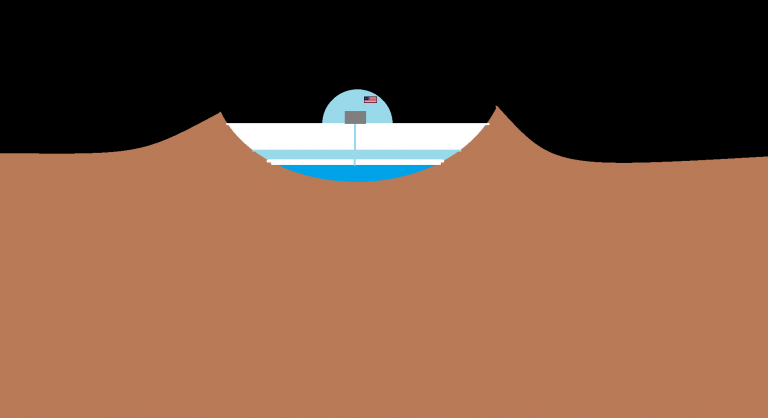
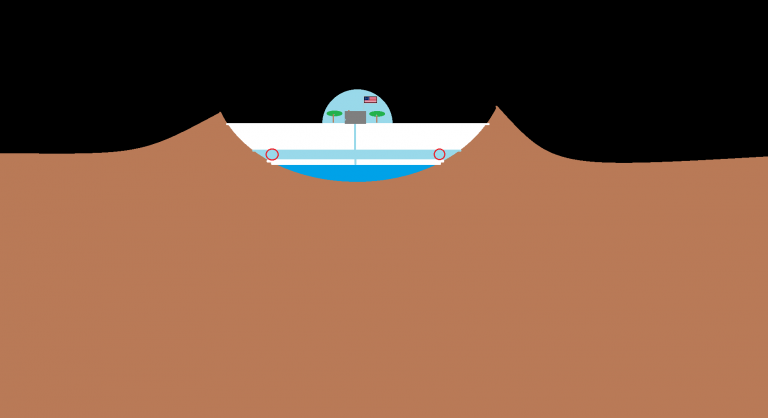
Last edited by PhotonBytes (2024-05-17 10:13:51)
I play the piano
https://fb.watch/s7XPqxw02-/
Offline
#2 2024-05-17 07:08:26
- tahanson43206
- Moderator

- Registered: 2018-04-27
- Posts: 19,421
Re: Mega Igloo ice cavity in Korolev Crater
This post is reserved for an index to posts that may be contributed by NewMars members over time.
(th)
Offline
#3 2024-05-17 09:24:34
- Void
- Member
- Registered: 2011-12-29
- Posts: 7,824
Re: Mega Igloo ice cavity in Korolev Crater
It looks good, PhotonBytes. I think that Calliban might be able to help you on your dome. I do have had my own notions on this, but this is your garden to tend to. I will stand aside.
Done
About post #4 which follows:
I will comment lightly then if you like that PhotonBytes. I have a tendency to be overbearing, which needs moderation.
Done
Last edited by Void (2024-05-17 10:52:18)
End ![]()
Offline
#4 2024-05-17 10:18:58
- PhotonBytes
- Member
- From: USA
- Registered: 2019-12-28
- Posts: 58
Re: Mega Igloo ice cavity in Korolev Crater
It looks good, PhotonBytes. I think that Calliban might be able to help you on your dome. I do have had my own notions on this, but this is your garden to tend to. I will stand aside.
Done
By all means show and tell, were all in this together, the more options there are to choose from the better the chances we have an optimal design.
I play the piano
https://fb.watch/s7XPqxw02-/
Offline
#5 2024-05-17 13:32:37
- Void
- Member
- Registered: 2011-12-29
- Posts: 7,824
Re: Mega Igloo ice cavity in Korolev Crater
https://en.wikipedia.org/wiki/Korolev_(Martian_crater)
Quote:
Korolev crater is located on the Planum Boreum, the northern polar plain which surrounds the north polar ice cap, near the Olympia Undae dune field. The crater rim rises about 2 kilometres (1.2 mi) above the surrounding plains. The crater floor lies about 2 kilometres (1.2 mi) below the rim, and is covered by a 1.8 kilometres (1.1 mi) deep central mound of permanent water ice, up to 60 kilometres (37 mi) in diameter.[2]
So, under the ice the pressure might be?
Calculations:
-1.2 miles, converted to feet: 6336
-Water needs to be about 100 feet deep on Mars to give about 1 bar of pressure.
-But clean ice is only 90% of that, so you need maybe about let's say 110 feet of clean ice to make one bar of pressure on Mars (Approximately).
-6336/110 = 57.6 bars of pressure so that is pretty high. Much too high for humans to work in without extreme pressure equipment, such as a Jim suit.
I suggest making more shallow lakes around the perimeter of the crater, probably on the north side of the ice mass, so as to be sun facing.
Then also place a good load of regolith on the bottoms of the lake to hold the ice down. Otherwise, the ice being about 90% of the weight of fresh water may crack and heave upwards, letting the water flow under it.
The north face of the rim could have various solar devices on it to provide power and even to reflect extra light onto your lakes.
But I will hold my interference at this point and see what you are thinking.
Done
Last edited by Void (2024-05-17 13:49:57)
End ![]()
Offline
#6 2024-05-17 17:16:04
- PhotonBytes
- Member
- From: USA
- Registered: 2019-12-28
- Posts: 58
Re: Mega Igloo ice cavity in Korolev Crater
https://en.wikipedia.org/wiki/Korolev_(Martian_crater)
Quote:Korolev crater is located on the Planum Boreum, the northern polar plain which surrounds the north polar ice cap, near the Olympia Undae dune field. The crater rim rises about 2 kilometres (1.2 mi) above the surrounding plains. The crater floor lies about 2 kilometres (1.2 mi) below the rim, and is covered by a 1.8 kilometres (1.1 mi) deep central mound of permanent water ice, up to 60 kilometres (37 mi) in diameter.[2]
So, under the ice the pressure might be?
Calculations:
-1.2 miles, converted to feet: 6336
-Water needs to be about 100 feet deep on Mars to give about 1 bar of pressure.
-But clean ice is only 90% of that, so you need maybe about let's say 110 feet of clean ice to make one bar of pressure on Mars (Approximately).
-6336/110 = 57.6 bars of pressure so that is pretty high. Much too high for humans to work in without extreme pressure equipment, such as a Jim suit.I suggest making more shallow lakes around the perimeter of the crater, probably on the north side of the ice mass, so as to be sun facing.
Then also place a good load of regolith on the bottoms of the lake to hold the ice down. Otherwise, the ice being about 90% of the weight of fresh water may crack and heave upwards, letting the water flow under it.The north face of the rim could have various solar devices on it to provide power and even to reflect extra light onto your lakes.
But I will hold my interference at this point and see what you are thinking.
Done
We don't have to do the operation as large as like in the illustration, it can at first be just a small fration of that scale. 1 bar of vapor preassure can be achieved by raising the temperature of the water below very slightly. Use the Ideal Gas Law to calcuate. With a submarine style nuclear thermal reactor this can be achieved. The air cavity can be a small fraction of the ice so the ice basicly acts like air tightbvolcanic veins that can hold an air cavity with preassure partly because of their weight, density and thickness combined. I woud love adding regolith inside the dome but will think about what you said. The edge of the ice at the crater rim should not be disturbed.
Last edited by PhotonBytes (2024-05-17 17:21:06)
I play the piano
https://fb.watch/s7XPqxw02-/
Offline
#7 2024-05-17 17:27:00
- Void
- Member
- Registered: 2011-12-29
- Posts: 7,824
Re: Mega Igloo ice cavity in Korolev Crater
As I said, this should be your place to garden, but you gave me what I consider a limited license to propose alternatives.
Do it your way by all means, and good luck with it.
Done
End ![]()
Offline
#8 2024-05-18 10:11:25
- Void
- Member
- Registered: 2011-12-29
- Posts: 7,824
Re: Mega Igloo ice cavity in Korolev Crater
Here is a resource you might want to study, which is associated with Dr. Zubrin: https://www.centauri-dreams.org/2020/05 … -for-mars/
It has lots of numbers, in a better style than mine.
I really would like to see your adaptations PhotonBytes.
Done
Last edited by Void (2024-05-18 10:12:26)
End ![]()
Offline
#9 2024-05-18 14:37:06
- PhotonBytes
- Member
- From: USA
- Registered: 2019-12-28
- Posts: 58
Re: Mega Igloo ice cavity in Korolev Crater
Here is a resource you might want to study, which is associated with Dr. Zubrin: https://www.centauri-dreams.org/2020/05 … -for-mars/
It has lots of numbers, in a better style than mine.
I really would like to see your adaptations PhotonBytes.
Done
Ok now I feel embarassed for messaging Dr Zubrin about my idea! I can understand now why he was silent it's because he has throught of this idea too! Although not exactly like mine and without a 1g centrigue which would basicly be hundreds of km of hypertube. I like to think things top down instead of bottom up!
I totally agree with the article he wrote it makes sense and is infact almost identical to my thinking especially electrolyzing water for oxygen. The minor adjustment I would make in my grand vision would be to store the hydrogen for lighter than air ships like the ones I have been promoting in the other post. The reason is because hydrogen has a tendency to leak, so it's good that there is water on Mars so we can replenish lighter than air gasses for airships.
https://newmars.com/forums/viewtopic.php?id=10762
If I had things my way I would first focus on landing an airship HAPs into the Martian atmosphere without touching the ground,

then flying it to Korolev Crater and landing on it like in the illustrations above. But instead of StarShip the Saucer will use it's onboard nuclear thermal reactor to melt a hole down the ice. The airship will have to extract much of the water and take it onbard so that the ship is no longer lighter than air and can have sufficient weight to cover the hole into the high preassure region where the water is.

In this adjustment you have a floating city sitting on the ice and doing the same thing in the illustration with the support of the equivelent of a small city along with all the creature comforts including a 1g centrifuge and real estate to walk around in.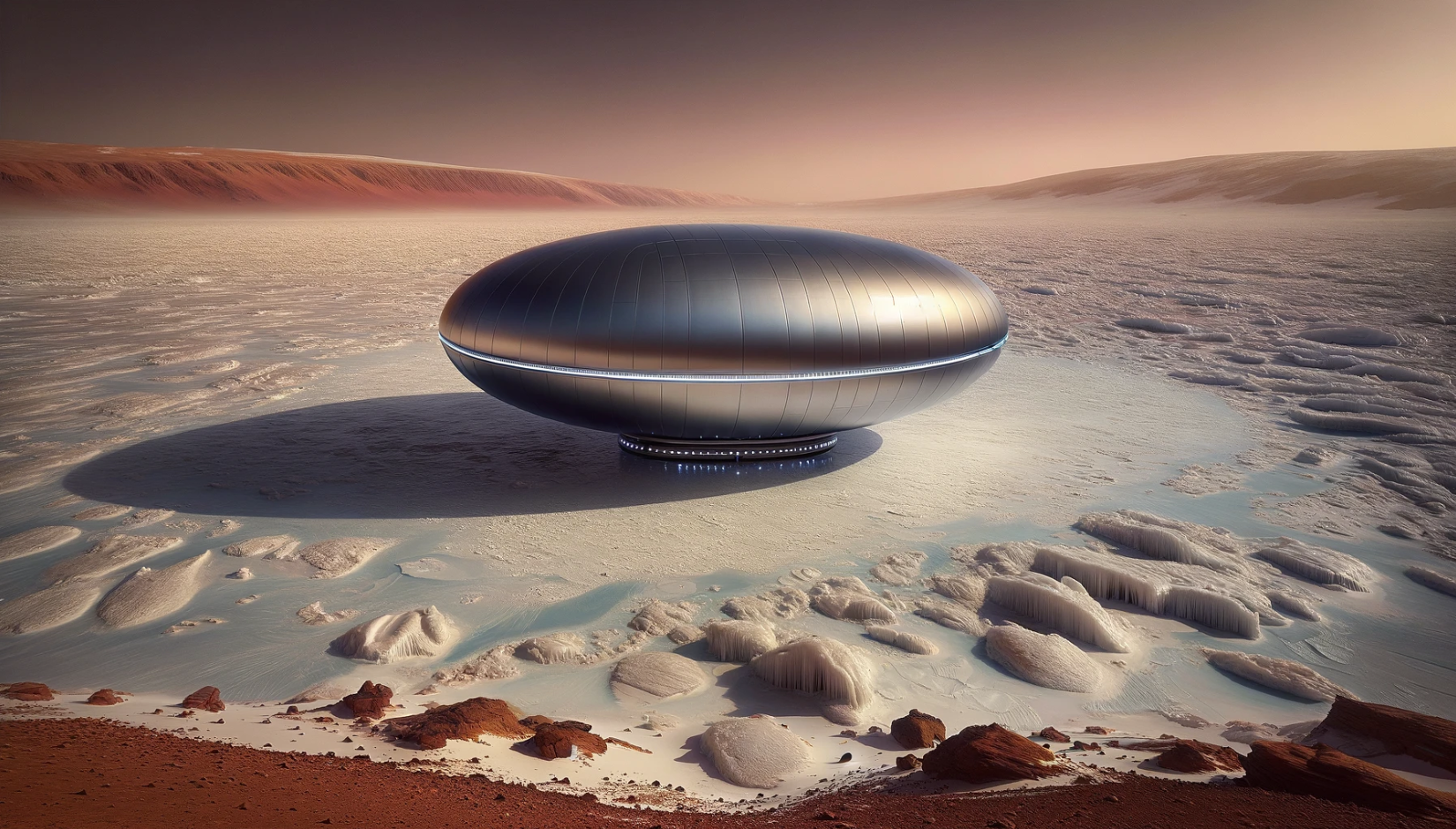
Last edited by PhotonBytes (2024-05-18 14:51:02)
I play the piano
https://fb.watch/s7XPqxw02-/
Offline
#10 2024-05-18 16:07:18
- Void
- Member
- Registered: 2011-12-29
- Posts: 7,824
Re: Mega Igloo ice cavity in Korolev Crater
I recall in one of Arthur C. Clarks books, perhaps 2010 Space Odyssey, where the story had a creature coming up out from a crack in the ice of Europa. So, that is where I first got the idea of pressurization of a liquid by ice and the liquid itself without a very substantial atmosphere.
We have talked of similar things here from time to time in the past.
It is good that you thought of it also.
Done
Last edited by Void (2024-05-18 16:08:34)
End ![]()
Offline
#11 2024-05-19 11:00:15
- SpaceNut
- Administrator

- From: New Hampshire
- Registered: 2004-07-22
- Posts: 29,433
Re: Mega Igloo ice cavity in Korolev Crater
PhotonBytes and Void we have talked about Korolev Crater and another for making use of what is a combination of dry ice and water but for anyone to use it we will need to land just off to one side of the crater to bring a preload of material assets to bring into the crater for use. These are required to build the isolation platform so as to have the location not melt with the rockets landings or take off from the surface.
Under the surface it's about load counterbalance for pressure of living area versus the materials above the people. Of course, this places less load on structure to keep this material above the people without over pressurizing that are that man resides within.
Offline
#12 2024-05-19 12:19:33
- PhotonBytes
- Member
- From: USA
- Registered: 2019-12-28
- Posts: 58
Re: Mega Igloo ice cavity in Korolev Crater
PhotonBytes and Void we have talked about Korolev Crater and another for making use of what is a combination of dry ice and water but for anyone to use it we will need to land just off to one side of the crater to bring a preload of material assets to bring into the crater for use. These are required to build the isolation platform so as to have the location not melt with the rockets landings or take off from the surface.
Under the surface it's about load counterbalance for pressure of living area versus the materials above the people. Of course, this places less load on structure to keep this material above the people without over pressurizing that are that man resides within.
That's why an airship is perfect. No rockets used to land. We have to figure out how to enter Mar's atmosphere with an inflated airship which I imagine will remain inflated from it's journey from Earth to Mars. I do not anticipate a huge problem to the insertion of an airship into the atmopshere of Mars because Mars has a low gravity and a thin atmosphere, so what we think might be a turbulant ride entering Earth's atmosphere would not apply on Mars. The large surface area of an airship would help it aerobrake gradually in the upper levels of Mars and then it can free fall into the denser lower regions of the atmosphere before floating at a set altitude. We could use nuclear electric system to use ionwind propulsion which might be more efficient in thinner less dense atmosphere compared to props. I'm not saying the airship wont have rockets, sure it will, just not for landing on Mars. Any rocket burn will be in the upper regions of the atmosphere during gradual aerobraking. We might even use plasma drives in combo with combustion rockets. The regular rocket would rapidly drop the speed of the airship and then turn off leaving only the plasma drives to assist with reducing speed for a steep drop into the lower regions of the atmosphere.
BTW I think the ice is going to be kms thick above any possible water under. So I don't think landing a rocket on it will drill all the way to liquid water. But if I'm wrong about that the airship is a good solution to just land like a cushion.
Last edited by PhotonBytes (2024-05-19 13:46:20)
I play the piano
https://fb.watch/s7XPqxw02-/
Offline
#13 2024-05-19 13:32:56
- Calliban
- Member
- From: Northern England, UK
- Registered: 2019-08-18
- Posts: 3,794
Re: Mega Igloo ice cavity in Korolev Crater
I don't think an airship is a viable way of lifting anything heavy on Mars. Atmospheric density is only about 0.013kg/m3. That really isn't much lift at all. A hydrogen filled balloon 100m in diameter will lift only 6.8t, most of which will be taken up by the envelope.
In fact transportation of anything on Mars is a real challenge. There isn't enough air to allow bouyant or aerodynamic flight. Ballistic rockets are an option. But that is an expensive and dangerous way to travel. There are no seas to float a boat in. No railways and no roads. If you want to transport something large over a long distance, you probably need a tracked vehicle.
"Plan and prepare for every possibility, and you will never act. It is nobler to have courage as we stumble into half the things we fear than to analyse every possible obstacle and begin nothing. Great things are achieved by embracing great dangers."
Offline
#14 2024-05-19 13:51:47
- PhotonBytes
- Member
- From: USA
- Registered: 2019-12-28
- Posts: 58
Re: Mega Igloo ice cavity in Korolev Crater
I don't think an airship is a viable way of lifting anything heavy on Mars. Atmospheric density is only about 0.013kg/m3. That really isn't much lift at all. A hydrogen filled balloon 100m in diameter will lift only 6.8t, most of which will be taken up by the envelope.
In fact transportation of anything on Mars is a real challenge. There isn't enough air to allow bouyant or aerodynamic flight. Ballistic rockets are an option. But that is an expensive and dangerous way to travel. There are no seas to float a boat in. No railways and no roads. If you want to transport something large over a long distance, you probably need a tracked vehicle.
Please refer to this post:
https://newmars.com/forums/viewtopic.php?id=10762
Refernce Spreadsheet:
https://docs.google.com/spreadsheets/d/ … ue&sd=true
Last edited by PhotonBytes (2024-05-19 13:53:31)
I play the piano
https://fb.watch/s7XPqxw02-/
Offline
#15 2024-05-19 14:04:02
- SpaceNut
- Administrator

- From: New Hampshire
- Registered: 2004-07-22
- Posts: 29,433
Re: Mega Igloo ice cavity in Korolev Crater
That chart shows earth atmospheric altitude where the pressure of earth high altitude is the same as ground level on mars. It's also not possible to inflate at orbital and have it enter due to friction speed as its going to fall to mars even from a dead stop at mars gravity rate that will increase until the envelope of the diameter starts to give drag.
Pioneer Astronautics Experimental Mars Balloon Inflation System Successfully Tested at 116,000 ft. earth Altitude.
Balloon Design for Mars, Venus, and Titan Atmospheres
another topic talking about this crater.
It is a key element to be able for man to do more than visit the mars surface.
update other topics that relate:
Balloon (balloons) on Mars - Facts vs Fantastic vision
Good question China weather balloon or spy craft but we are not mars for what PhotonBytes is looking to do.
Balloon Tourist Flights on Earth
Balloon or dirigible for Mars "hot air" or gas filled
Automotive industry, Martian Balloons, automobile manufacture on Mars.
Offline
#16 2024-05-19 14:10:26
- PhotonBytes
- Member
- From: USA
- Registered: 2019-12-28
- Posts: 58
Re: Mega Igloo ice cavity in Korolev Crater
That chart shows earth atmospheric altitude where the pressure of earth high altitude is the same as ground level on mars. It's also not possible to inflate at orbital and have it enter due to friction speed as its going to fall to mars even from a dead stop at mars gravity rate that will increase until the envelope of the diameter starts to give drag.
Pioneer Astronautics Experimental Mars Balloon Inflation System Successfully Tested at 116,000 ft. earth Altitude.
Hello, that chart shows the conditions on Mars. If it were Earth the number that says 3.7 in the cell that calculates payload would say instead 9.8. I am assuming you understand college level physics?
Further more notice in the spreadsheet and chart you were almost right about what a 50m (100m diameter) radius balloon would do on Mars. Not on Earth. How can you get the right answer on my chart if it was for Earth?
https://docs.google.com/spreadsheets/d/ … ue&sd=true
Last edited by PhotonBytes (2024-05-19 14:15:44)
I play the piano
https://fb.watch/s7XPqxw02-/
Offline
#17 2024-05-19 14:42:15
- Calliban
- Member
- From: Northern England, UK
- Registered: 2019-08-18
- Posts: 3,794
Re: Mega Igloo ice cavity in Korolev Crater
PhotonBytes, how much would the envelope weigh? In theory, you could keep scaling up lift just by making the envelope diameter and enclosed volume, greater and greater. But in reality, the lifting gas in the envelope has to transfer lift to the envelope. So there is a pressure difference created by lift pushing against the top of the envelope. So the weight of the envelope scales with volume rather than surface area. But the envelope will need to be thicker at the top than it is at the bottom. You could taper it to save weight. But with only 13 grams of lift per cubic metre, there isn't a lot of lift to work with.
A radius of 201m equates to an enclosed volume of 34 million cubic metres. That is 243 times the lifting gas volume of the Hindenburg, which was already about the size of the Titanic. That would certainly be an impressive balloon. Yet even that city sized balloon would provide a lift of only about 400 metric tonnes. That isn't much for something so big.
Last edited by Calliban (2024-05-19 14:57:18)
"Plan and prepare for every possibility, and you will never act. It is nobler to have courage as we stumble into half the things we fear than to analyse every possible obstacle and begin nothing. Great things are achieved by embracing great dangers."
Offline
#18 2024-05-19 15:04:02
- PhotonBytes
- Member
- From: USA
- Registered: 2019-12-28
- Posts: 58
Re: Mega Igloo ice cavity in Korolev Crater
PhotonBytes, how much would the envelope weigh? In theory, you could keep scaling up lift just by making the envelope diameter and enclosed volume, greater and greater. But in reality, the lifting gas in the envelope has to transfer lift to the envelope. So there is a pressure difference created by lift pushing against the top of the envelope. So the weight of the envelope scales with volume rather than surface area. But the envelope will need to be thicker at the top than it is at the bottom. You could taper it to save weight. But with only 13 grams of lift per cubic metre, there isn't a lot of lift to work with.
A radius of 201m equates to an enclosed volume of 34 million cubic metres. That is 243 times the lifting gas volume of the Hindenburg, which was already about the size of the Titanic. That would certainly be an impressive balloon. Yet even that city sized balloon would provide a lift of only about 400 metric tonnes. That isn't much for something so big.
Caliban, each time you double the radius you increase the volume 8 times and the surface area 4 times. So the larger the balloon the less material you need per unit of volume. If you're unfamiliar with the maths of volume of a sphere and surface area of a sphere you can google or ask AI to confirm what I say.
hint: Each unit of volume is what causes lift. THE BIGGER THE BETTER!
Keywords for this theme:
1. Economies of scale
2. Scale Effect
So why didnt those PhDs you quoted or NASA themselves figure this out? The one thing I realized about human beings is that they sometimes have a "failure of imagination". No matter how smart they are. Want proof? Go back to Apollo 1. That capsule that caught on fire and killed all the astronauts. How come all those smart guys at NASA and the PhDs didnt think that it would be dangerous to fill that capsule up with so much pure oxygen at high pressures? Pretty commonsense now right? Why wasn't it commonsense back then? This is why I don't focus on other people's research although I do think it's a good idea before one starts a project or research to do exactly that for papers that have similar theme. But there are soooooo many now and its very very very easy to get lost in other peoples opinions about this and that. I rather focus on the maths and the basic laws of physics. If people did that more often with their time instead of regurgitating other's ideas and opinions without even understanding it, it's a waste of time.
Last edited by PhotonBytes (2024-05-19 15:20:36)
I play the piano
https://fb.watch/s7XPqxw02-/
Offline
#19 2024-05-19 15:28:05
- Calliban
- Member
- From: Northern England, UK
- Registered: 2019-08-18
- Posts: 3,794
Re: Mega Igloo ice cavity in Korolev Crater
PhotonBytes, I am quite familar with declining surface area per unit volume for a sphere of increasing size. The problem is that as balloon diameter increases, the thickness of the fabric also has to increase. It doesn't stay the same. That is because as diameter scales up, each square metre of fabric on the top of the envelope is taking more load, i.e lift per unit area is increasing. This is because the depth of lifting gas underneath the top of the envelope is increasing.
The 'lifting pressure' on the fabric will be a maximum at the top and will be zero at the bottom. So you can taper the skin thickness so it is thicker at the top and thinner at the bottom. The problem is that you still need to transfer lift to whatever you are lifting. If this is done through the fabric of the balloon, tensile stress will be uniform within the fabric. So fabric mass ends up scaling with volume rather than surface area. That means for a balloon of any size, the envelope mass will be a fixed fraction of total lift.
This is why I asked how heavy your envelope is. You need to calculate the maximum skin stress that the material can withstand and then work out skin thickness for each envelope diameter and load. You then multiply surface area by skin thickness and density to get envelope mass.
Last edited by Calliban (2024-05-19 15:33:00)
"Plan and prepare for every possibility, and you will never act. It is nobler to have courage as we stumble into half the things we fear than to analyse every possible obstacle and begin nothing. Great things are achieved by embracing great dangers."
Offline
#20 2024-05-19 15:31:08
- PhotonBytes
- Member
- From: USA
- Registered: 2019-12-28
- Posts: 58
Re: Mega Igloo ice cavity in Korolev Crater
PhotonBytes, I am quite familar with declining surface area per unit volume for a sphere of increasing size. The problem is that as balloon diameter increases, the thickness of the fabric also has to increase. It doesn't stay the same. That is because as diameter scales up, each square metre of fabric on the top of the envelope is taking more load, i.e lift per unit area is increasing. This is because the depth of lifting gas underneath the top of the envelope is increasing.
The 'lifting pressure' on the fabric will be a maximum at the top and will be zero at the bottom. So you can taper the skin thickness so it is thicker at the top and thinner at the bottom. The problem is that you still need to transfer lift to whatever you are lifting. If this is done through the fabric of the balloon, tensile stress will be uniform within the fabric. So fabric mass ends up scaling with volume rather than surface area.
This is not a problem at all, if it was a problem we would not have amazing things in the past like rigid airships.
I play the piano
https://fb.watch/s7XPqxw02-/
Offline
#21 2024-05-19 15:53:01
- Calliban
- Member
- From: Northern England, UK
- Registered: 2019-08-18
- Posts: 3,794
Re: Mega Igloo ice cavity in Korolev Crater
What it means is:
1. Lift scales with enclosed volume.
2. Therefore the forces acting on your balloon outer skin scale with volume.
3. Therefore, if using the same materials for construction with the same tensile strength, the mass must also scale with volume, NOT surface area.
So a balloon enclosing 1000x the volume will generate 1000x the lift, but will also have 1000x the mass. There isn't any way of getting around this. If a balloon of given diameter has 1t lift and weighs 0.8t, then it can lift 0.2t of payload. If you make the balloon 10x wider using the same material, its total lift increases to 1000t. But it will weigh 800t and will lift 200t payload. The ratio remains the same, because the skin has to get thicker to support a load that is scaling with volume.
If we build truly enormous balloons, then we could start running into problems with atmospheric pressure gradient. But I think that would only happen if they got to being a km or more in diameter. A 400m diameter balloon wouldn't face that problem.
"Plan and prepare for every possibility, and you will never act. It is nobler to have courage as we stumble into half the things we fear than to analyse every possible obstacle and begin nothing. Great things are achieved by embracing great dangers."
Offline
#22 2024-05-19 15:56:20
- PhotonBytes
- Member
- From: USA
- Registered: 2019-12-28
- Posts: 58
Re: Mega Igloo ice cavity in Korolev Crater
What it means is:
1. Lift scales with enclosed volume.
2. Therefore the forces acting on your balloon outer skin scale with volume.
3. Therefore, if using the same materials for construction with the same tensile strength, the mass must also scale with volume, NOT surface area.So a balloon enclosing 1000x the volume will generate 1000x the lift, but will also have 1000x the mass. There isn't any way of getting around this. If a balloon of given diameter has 1t lift and weighs 0.8t, then it can lift 0.2t of payload. If you make the balloon 10x wider using the same material, its total lift increases to 1000t. But it will weigh 800t and will lift 200t payload. The ratio remains the same, because the skin has to get thicker to support a load that is scaling with volume.
If we build truly enormous balloons, then we could start running into problems with atmospheric pressure gradient. But I think that would only happen if they got to being a km or more in diameter. A 400m diameter balloon wouldn't face that problem.
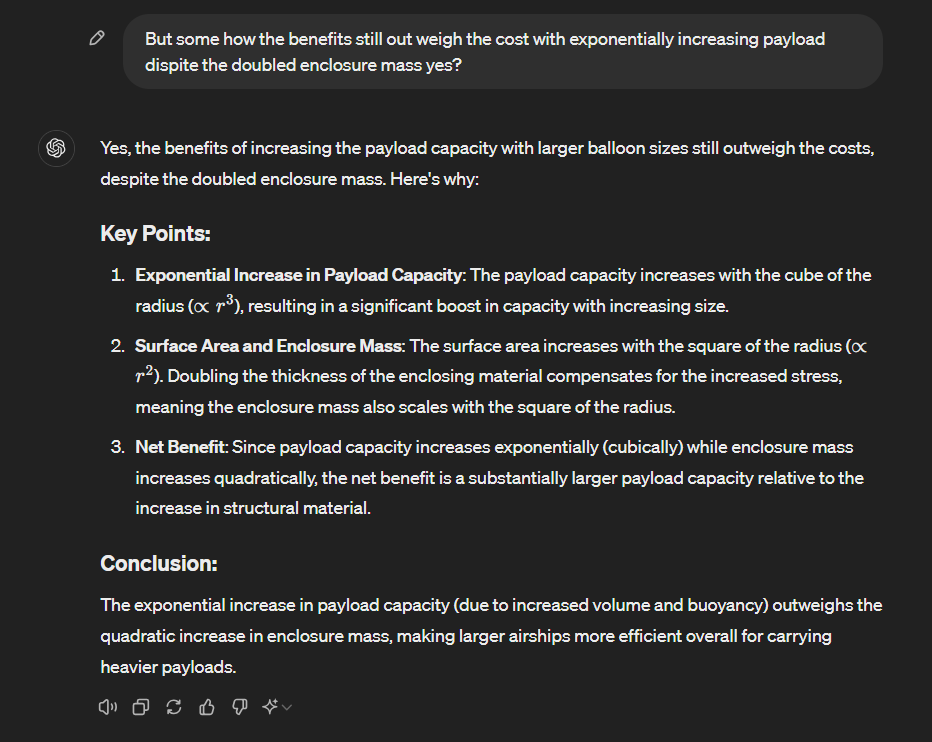
Ok because you cannot scroll up this image I'll explain what was discussed with AI before the screenshot.
Basicly when you double the radius you 8 times the volume, 4 times the surface area and you 2 times the balloon material to compensate completely for the increased forces experienced. However 2 times the material mass is only a fraction of the 8 times in lifting ability. And that fraction reduces each time you double the radius!
Btw, thanks for bringing this up and not giving up trying to call me out, because of this it got me thinking about this ahead of schedule and I didn't actually know about the doubling of material as a compensation which is something I was eventually going to tackle and find out anyways but thanks for speeding up the process of me designing an interstella Airship. It will probably be saucer shaped not spherical and most of the payload will be part of the enclosing material discussed to further enhance the ability of the ship to handle stress. The flying saucer is going to have most of its mass as part of it's outer protective shell - This is a potential future post "Interstellar HAPs"
Last edited by PhotonBytes (2024-05-19 16:26:56)
I play the piano
https://fb.watch/s7XPqxw02-/
Offline
#23 2024-05-19 16:34:29
- Calliban
- Member
- From: Northern England, UK
- Registered: 2019-08-18
- Posts: 3,794
Re: Mega Igloo ice cavity in Korolev Crater
Unfortunately, no. The weight of the balloon scales with its lift, unless you can use a stronger material. The old airship engineers did consider using sheet metal to make outer covers and gas cells. The reason you can do that with very large airships and not smaller ones, is that minimum skin thickness increases to an achievable guage. Foils can only be made so thin. But skin weight still scales with volume if you are using the same material with the same tensile strength. The old airships used cotton for outer covers and cotton lined with cow guts for gas cells. They would get away with using such weak materials, because the forces were transfered to the metal frame which took most of the stress. The outer cover mass scaled with surface area, but the frame mass still had to scale with volume, because lifting force scaled with volume.
Think about it like this. You hang a weight from a piece of wire that is just strong enough to hold it. If you want to double the weight you hang from the wire, you must double the cross sectional area of the wire so that the stress remains the same. Otherwise it snaps. It is the same with your balloon. It is a balance of forces between the weight it is carrying and the lift that the gas inside is providing. If you scale up the diameter without making the fabric proportionately thicker, then the skin stress increases and it bursts. Making the balloon bigger may allow more options in terms of the materials you can use to make it. And that is something worth exploring. But it doesn't change the fact that the skin mass of your balloon scales with volume if using the same material.
None of this in itself tells us that a lifting balloon cannot work on Mars.
"Plan and prepare for every possibility, and you will never act. It is nobler to have courage as we stumble into half the things we fear than to analyse every possible obstacle and begin nothing. Great things are achieved by embracing great dangers."
Offline
#24 2024-05-19 18:23:57
- PhotonBytes
- Member
- From: USA
- Registered: 2019-12-28
- Posts: 58
Re: Mega Igloo ice cavity in Korolev Crater
Unfortunately, no. The weight of the balloon scales with its lift, unless you can use a stronger material. The old airship engineers did consider using sheet metal to make outer covers and gas cells. The reason you can do that with very large airships and not smaller ones, is that minimum skin thickness increases to an achievable guage. Foils can only be made so thin. But skin weight still scales with volume if you are using the same material with the same tensile strength. The old airships used cotton for outer covers and cotton lined with cow guts for gas cells. They would get away with using such weak materials, because the forces were transfered to the metal frame which took most of the stress. The outer cover mass scaled with surface area, but the frame mass still had to scale with volume, because lifting force scaled with volume.
Think about it like this. You hang a weight from a piece of wire that is just strong enough to hold it. If you want to double the weight you hang from the wire, you must double the cross sectional area of the wire so that the stress remains the same. Otherwise it snaps. It is the same with your balloon. It is a balance of forces between the weight it is carrying and the lift that the gas inside is providing. If you scale up the diameter without making the fabric proportionately thicker, then the skin stress increases and it bursts. Making the balloon bigger may allow more options in terms of the materials you can use to make it. And that is something worth exploring. But it doesn't change the fact that the skin mass of your balloon scales with volume if using the same material.
None of this in itself tells us that a lifting balloon cannot work on Mars.
Unfortunately no for what precisely? The weight of the balloon scales with lift? Can you show me a reference for that? Get AI to admit that or something or an old highschool text book. And scales how? Directionally porportionally? Show me something that disagrees with the above comment by AI.
"The old airship engineers did consider using sheet metal to make outer covers and gas cells." - They not only considered it, they implemented it. Look at the link I referenced above about metal-clad ships.
" The old airships used cotton for outer covers and cotton lined with cow guts for gas cells. They would get away with using such weak materials, because the forces were transfered to the metal frame which took most of the stress. The outer cover mass scaled with surface area, but the frame mass still had to scale with volume, because lifting force scaled with volume." - ok now youre starting to make a bit more sense, yes they had a solution and we can use that same solution. In fact I have been trying to convey to you that those cables can double as payload. Build cabins into them. But again we are getting ahead of ourselves, we were debating wether balloons can work on Mars or not, we were not talking about how to build them. Are we changing the topic after agreeing that they do work on Mars?
Also, do you know what a non-rigid airship is? We can use higher pressure cells to compensate for not needing as much internal frame. Higher preassure but not higher density. In this way we can have a hybrid Blimp-Rigid Airship that has less internal frame mass.
Also as I said to you before you can allocate payload mass to the skin it self(meaning rooms/cabins to toughen it) and morph the sphere into a more oblisque or disc shape formation (this will also slow down ascent rate), I would imagine haveing a regular internal frame too on top of that but this frame will be smaller because of the squashed shape of the airship and the frame would again double as payload such as cabins so they play dual role . This is more of a design issue that is down the development stage. As you correctly pointed out the old guys had a solution and we can copy that solution and even enhance that. So I don't see where youre going with this non argument.
Fact remains, the bigger the airship the more efficient it is and the easier to build it(economically per unit of lift) not harder. AI confirmed this. Have you seen the current companies in the airship buisness? Have you looked at how big they are? Look up: Aerosmena
"Making the balloon bigger may allow more options in terms of the materials you can use to make it. And that is something worth exploring. But it doesn't change the fact that the skin mass of your balloon scales with volume if using the same material." - Hey this might be true but look at the above mentioned solutions and also, please back up your claims with a reference. It will be useful for me as I need verification. Again show me an AI quote. Again it sounds correct but I'm asking for your help here so I can do my work. In fact I would add to your statement yes they offer more options and one of those options is the ability to use vacuum balloons once you reach a certain height and you can evacuate or re-compress hydrogen back into the tanks. This is an idea of mine using rigid vacuum balloons. NASA is looking into vacuum balloons for Mars.
"None of this in itself tells us that a lifting balloon cannot work on Mars." - AWESOME! Lets go to Mars! Come on, be a little more positive!
Lastly: You do realize that just because you got a huge balloon doesn't mean you have to use all of that lift potential to stress out your material right? You can control your ascent rate to only climb at a small fraction of your lift potential. We have the technology.
P.S: I think we are getting off topic here since this thread is about Korolev Crater and how to terraform and live in it. Probably best we make another thread about how to design an airship since we obviously agree at this stage they can work on Mars. Or continue to chat in the more relevant and existing thread I started:
https://newmars.com/forums/viewtopic.php?id=10762
P.S.S
Had AI analyze your above statement too it concurred with what you said with this response: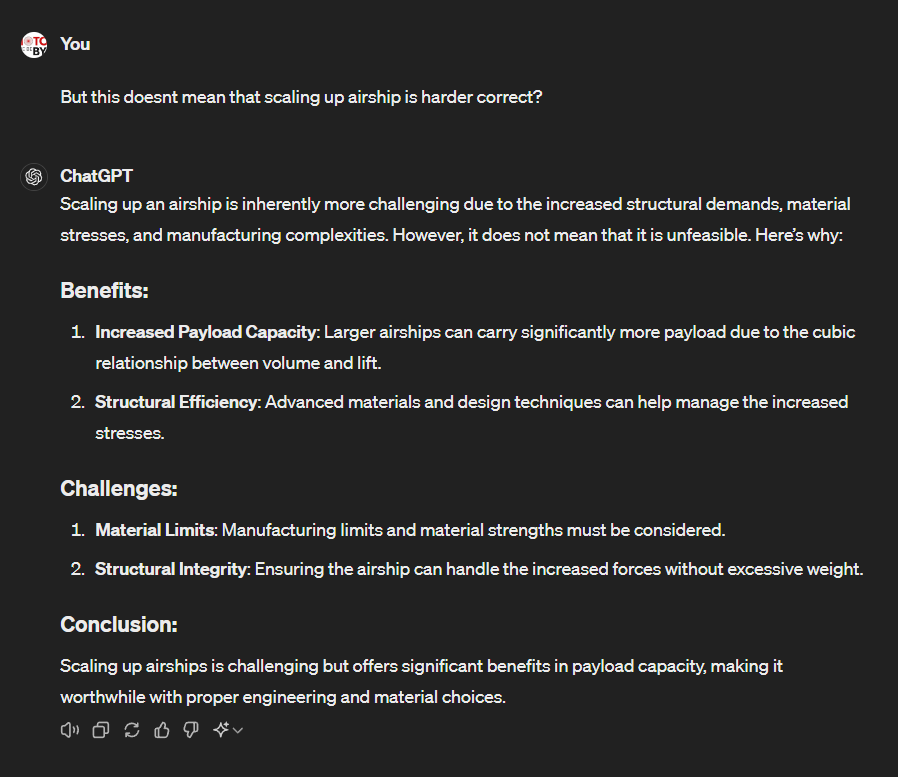
Last edited by PhotonBytes (2024-05-20 00:01:54)
I play the piano
https://fb.watch/s7XPqxw02-/
Offline
#25 2024-05-20 16:51:41
- SpaceNut
- Administrator

- From: New Hampshire
- Registered: 2004-07-22
- Posts: 29,433
Re: Mega Igloo ice cavity in Korolev Crater
Since we have high air balloons on Earth then the ability of Mars lift effectiveness of balloon is more than 100 times less on mars.

A mars balloon might appear like this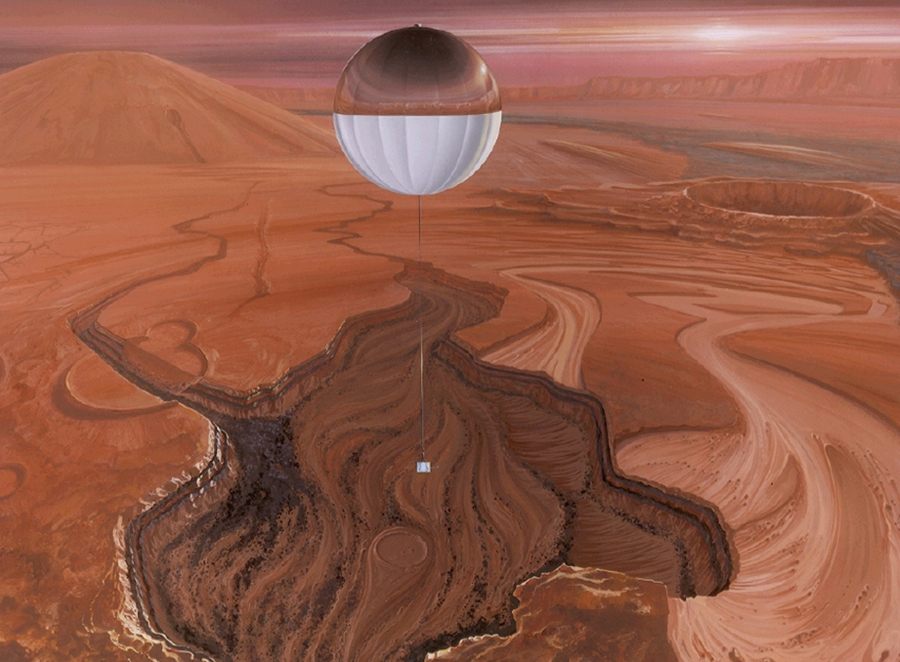
Offline